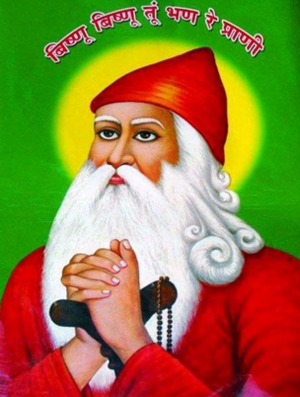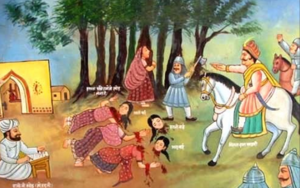Talk:Guru Jambheśvara (1451–1536 CE), the world’s first environmentalist
By Vishal Agarwal
Mother Earth has a limited amount of water, soil to grow crops, plants, animals, metals, and other resources for use by humans. Many of us waste these gifts of nature and also pollute our surroundings. An environmentalist is a person who studies the harmful effects of our activities on our surroundings and teaches others how we can avoid wasting or polluting natural resources like water.
Interestingly, one of the earliest environmentalists in the world was a Hindu saint named Jambhojī (also called Guru Jambheśvara).
He was born in 1451 at Pīpāsar in Rajasthan (India). The area is a desert, and trees as well as natural wildlife are scarce. In 1485, the area was hit with a very bad drought. People started fleeing the area with their cattle. Till then, Jambhojī made a living grazing his family’s cattle. He decided to help people affected by famine. He arranged for food grain, hay for cattle, and fertilizers for agriculture. With his help, many people were able to stay back in their homes.
Jambhojī realized that droughts happened not only because of low rainfall, but also because people were not taking care of their environment. They were cutting down trees for firewood and for wasteful activities. They killed the domestic and wild animals unnecessarily for cruel sports like hunting. They were wasting water. As a result, when rains failed to come, the people of that area had nothing to survive with.
Therefore, in that year, he performed a havan (a Vedic religious ceremony) and announced 29 rules. His followers therefore came to be known as Bishnoi — which means “they who follow 29 rules.”
These rules teach us how to live as a good human being, be neat and clean, be devoted to Bhagavān Viṣṇu, help others, and most importantly, preserve our environment.
For example, these rules say that:
- We must not hunt or kill animals for food or sport
- We must not fell green trees
- Be vegetarians
- Not hurt dairy cattle in any way
The ancient Vedic scriptures regarded the black antelope (called black-buck) as a sacred animal. The Bishnoi too forbade the killing of this animal. Further, the Khejarī tree that grew widely in that area and provided food for animals was declared as sacred, and no one was allowed to fell these trees.
Thanks to the efforts of Jambhoji Maharaj (who lived for 51 years after teaching these rules), large parts of the desert area became green with trees, and populated with wild animals once again. The following incident, that happened almost 200 years after Guru Jambheshwar’s lifetime shows how dedicated his followers were.
In 1730, the Rājpūt Maharaja of a kingdom named Jodhpur wanted wood for constructing his palace. He sent his prime minister and some soldiers to obtain wood from a Bishnoi village named Khejarli, because the Bishnoi villages had plenty of trees. However, a woman named Amrita Devi Bishnoi stopped the king’s men saying, “These trees are sacred to us. We will not allow you to cut them even if you chop off our heads!”
The prime minister did not want to return to Jodhpur empty handed. He ordered the soldiers to behead Amrita Devi. Then, her three daughters came forward and said, “You might have killed our mother, but we are not scared. You will have to cut our heads too before you can touch these trees.” Unfortunately, the cruel soldiers killed the three girls too.
One after another, men, women and children of the Bishnoi community of that village came out to offer their lives. In the next several hours, 363 people
preferred to get beheaded rather than allow the soldiers to cut their trees. When the shocking news reached the Maharaja, he was filled with remorse and apologized to the community. He issued a royal order that henceforth, trees will not be cut in the Bishnoi villages.
Even today, the massacre is remembered on its anniversary every year and people from far away areas come to the village for the function. The government of India gives an award named Amrita Devi Bishnoi Award every year to a person who has contributed a lot for protection of nature and wildlife.


